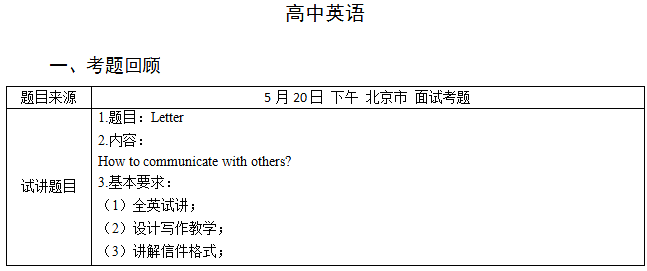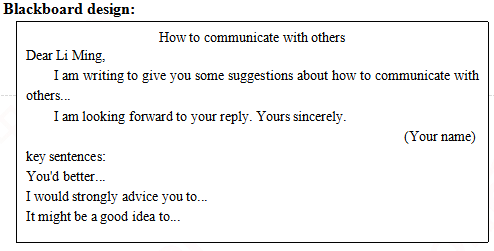2018上半年高中英語(yǔ)教師資格證面試真題及答案(第四批)

二、考題解析
【教案】
Teaching Aims:
Knowledge aim: By the end of the class, students will know some expressions of advice and the format of a letter, which includes: an appellation, a body part, a complimentary close and a signature.
Ability aim: Students’ writing ability of letter can be improved by the end of the class.
Emotional aim: Students will be aware of the importance of writing English letter.
Students' interest of learning English can be inspired.
Teaching Key Points:
Students know the format of an English letter and how to make a suggestion.
Teaching Difficult Points:
Students can apply expressions of advice and the format of English letter into their own life.
Teaching Methods:
Communicative teaching method, task-based teaching method, situational teaching method.
Teaching Aids:
PPT, Blackboard and so on
Teaching Procedures:
Step 1: Warming up
1.Greetings
2.Sing an English song We don’t talk anymore, invite the whole students to clap when singing together and lead to the topic.
Step 2: Pre-writing
1.Free talk: Let students talk about the importance of communication in our daily life in group of four, 3 minutes later invite some groups to show their ideas.
2.Set up situation: Let's say our friend Li Ming is very upset recently, because he has a problem in the aspect of communicating with others, we should write a letter to give him some advice.
3.Format: Guide and teach students the format of English letters, which includes: an appellation, a body part, a complimentary close and a signature.
4.Content: Teach students the key sentence structures about how to make a suggestion.(eg: I suggest that you...)
5.Brainstorming: Let students share their ideas about how to communicate with others with their partners, and decide which are the best ideas, make a list of those ideas, then put those ideas into a map so that students can easily see them when they write.
Step 3: While-wirting
Give students some guidance, such as: pay attention to the punctuation, sentence structure, tenses and format. 15 minutes would be given to them to complete their letter within 100 words individually.
Step 4: Post-writing
1.Self-editing: Ask students to check their letter according to the format and sentence structures on the blackboard.
2.Peer editing: Ask students to check and edit their partners’ letter and give them some suggestions.
3.Share: Invite some students to share their letter in front of the class and teacher gives them some comments.
Step 5: Summary & Homework
Summary : Invite a little teacher sum up what we have learned today.
Homework: Let students search more information about how to communicate with others.

人力資源考試教師資格考試出版專業(yè)資格健康管理師導(dǎo)游考試社會(huì)工作者司法考試職稱計(jì)算機(jī)營(yíng)養(yǎng)師心理咨詢師育嬰師事業(yè)單位教師招聘公務(wù)員公選考試招警考試選調(diào)生村官
初級(jí)會(huì)計(jì)職稱中級(jí)會(huì)計(jì)職稱經(jīng)濟(jì)師注冊(cè)會(huì)計(jì)師證券從業(yè)銀行從業(yè)會(huì)計(jì)實(shí)操統(tǒng)計(jì)師審計(jì)師高級(jí)會(huì)計(jì)師基金從業(yè)資格稅務(wù)師資產(chǎn)評(píng)估師國(guó)際內(nèi)審師ACCA/CAT價(jià)格鑒證師統(tǒng)計(jì)資格從業(yè)
一級(jí)建造師二級(jí)建造師消防工程師造價(jià)工程師土建職稱公路檢測(cè)工程師建筑八大員注冊(cè)建筑師二級(jí)造價(jià)師監(jiān)理工程師咨詢工程師房地產(chǎn)估價(jià)師 城鄉(xiāng)規(guī)劃師結(jié)構(gòu)工程師巖土工程師安全工程師設(shè)備監(jiān)理師環(huán)境影響評(píng)價(jià)土地登記代理公路造價(jià)師公路監(jiān)理師化工工程師暖通工程師給排水工程師計(jì)量工程師
執(zhí)業(yè)藥師執(zhí)業(yè)醫(yī)師衛(wèi)生資格考試衛(wèi)生高級(jí)職稱護(hù)士資格證初級(jí)護(hù)師主管護(hù)師住院醫(yī)師臨床執(zhí)業(yè)醫(yī)師臨床助理醫(yī)師中醫(yī)執(zhí)業(yè)醫(yī)師中醫(yī)助理醫(yī)師中西醫(yī)醫(yī)師中西醫(yī)助理口腔執(zhí)業(yè)醫(yī)師口腔助理醫(yī)師公共衛(wèi)生醫(yī)師公衛(wèi)助理醫(yī)師實(shí)踐技能內(nèi)科主治醫(yī)師外科主治醫(yī)師中醫(yī)內(nèi)科主治兒科主治醫(yī)師婦產(chǎn)科醫(yī)師西藥士/師中藥士/師臨床檢驗(yàn)技師臨床醫(yī)學(xué)理論中醫(yī)理論